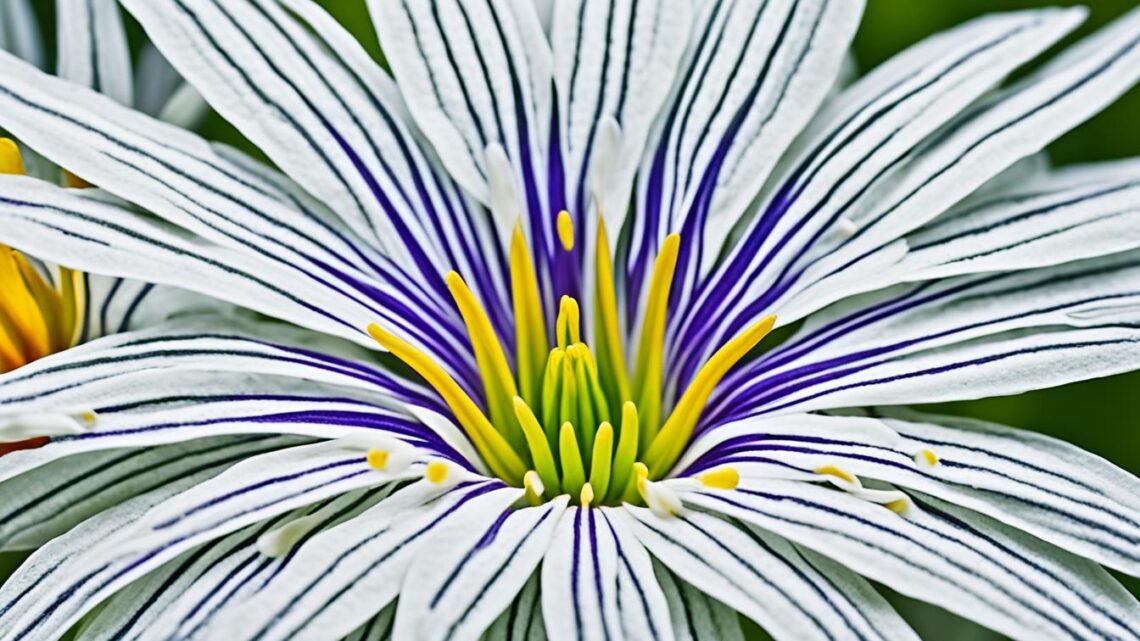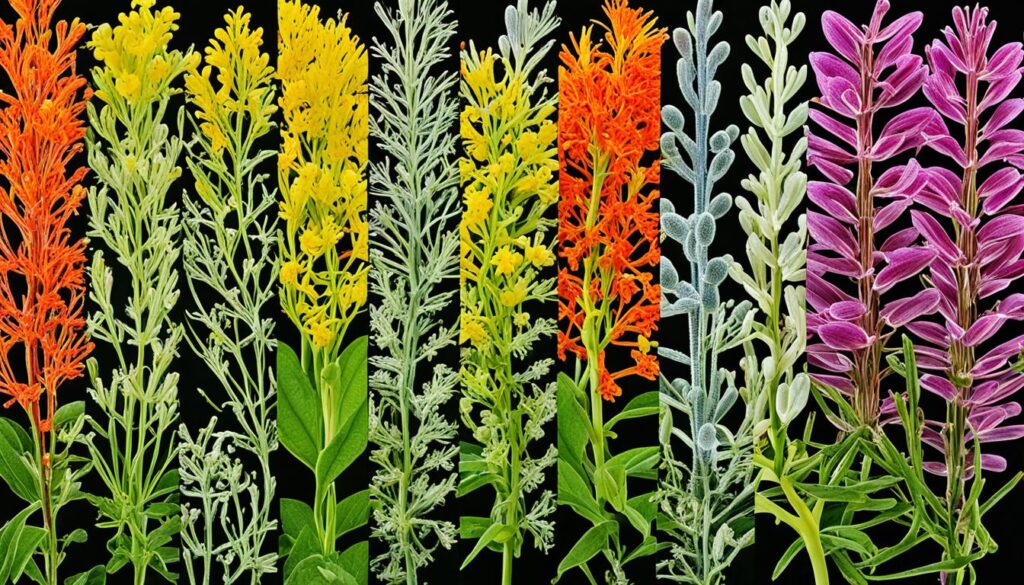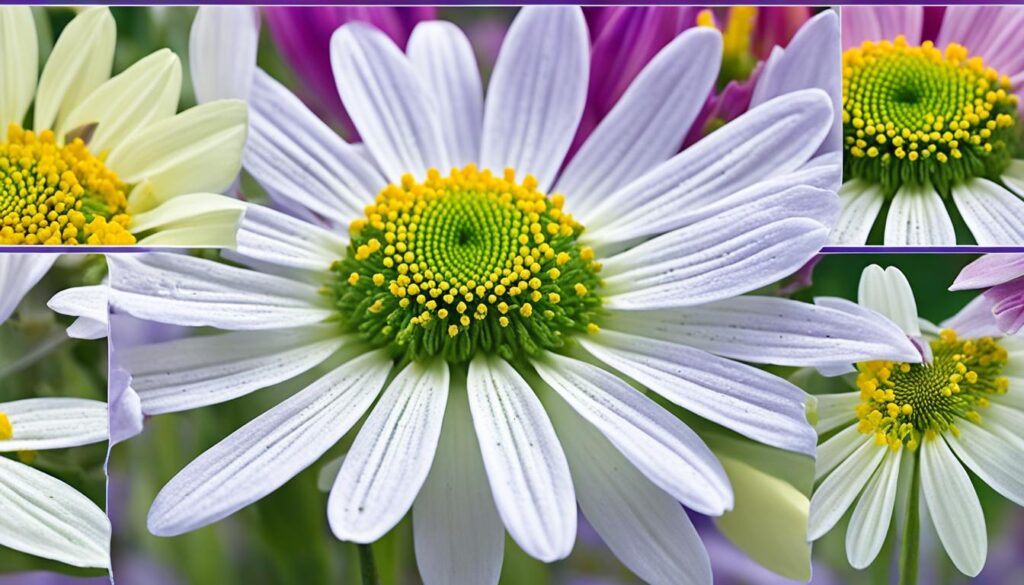
Have you ever stopped to marvel at the intricate beauty of a flower? Beneath the vibrant petals and alluring scents lies a world of fascinating floral anatomy. What are the essential parts that make up these captivating botanical wonders?
Let’s explore the secrets of a flower’s inner workings. Discover the key to understanding their remarkable reproductive capabilities.
The Fundamental Anatomy of a Flower
Flowers are the colorful and magical parts of plants. They come in many shapes and sizes. Their design is complex, with parts that help them grow and reproduce. Let’s explore the different types of flower anatomy.
Complete vs. Incomplete
Flowers can be either complete or incomplete. This depends on if they have all four main parts: sepals, petals, stamens, and carpels. A complete flower has all these parts. An incomplete flower is missing one or more.
Complete flowers have four main groups: the calyx, corolla, androecium, and gynoecium. Incomplete flowers don’t have all these parts. They look simpler.
Perfect vs. Imperfect
Flowers can also be perfect or imperfect. This means they can have both male (stamens) and female (carpels) parts in the same flower. A perfect flower has both, allowing it to pollinate itself. An imperfect flower has only one type, needing help from another flower to reproduce.
Flowers’ anatomy is key to how they make more plants. Knowing the differences between complete and incomplete, and perfect and imperfect flowers, helps us understand plant biology better.

Monoecious vs. Dioecious: Exploring Plant Sexuality
Plants have their own way of being sexual, different from what we see in animals. They have many ways to reproduce, each with its own benefits. Knowing about plant sexuality helps us understand how they adapt and fit into their environments.
Monoecious and dioecious are two main types of plant sexuality. Monoecious plants have both male and female parts in one plant, so they can pollinate themselves. Dioecious plants have separate male and female plants, needing cross-pollination to reproduce.
Corn is a great example of a monoecious plant. It has both male and female flowers on the same plant. The tassels at the top produce pollen, while the ears have the female parts. This way, corn can grow well in many places.
Dioecious plants are less common, making up about 5% of all plants. They need wind or animals to move pollen from the male to the female plants. Some dioecious plants include certain willows, hollies, and hemp.
How plants reproduce affects the environment. Monoecious plants can pollinate themselves, which helps them grow in many places. Dioecious plants need pollinators, which can limit where they can live and how they adapt to changes.
Learning about plant sexuality is interesting and useful. It helps in farming, managing forests, and saving endangered species. By understanding monoecious and dioecious plants, we can take better care of the ecosystems they live in.

Unveiling the Four Key Components
Every flower has a fascinating set of structures that play a key role in its reproduction. These include the sepal, petal, stamen, and carpel. Each part works together to help the plant reproduce. Let’s explore what makes each one special.
Sepal: The Protective Guardian
Sepals are like leaf-like structures that protect the flower bud. They are green and tough, keeping the delicate parts safe from harm. Sepals are essential for the flower’s structure, giving a strong base for the other parts.
Petals: Nature’s Vibrant Canvas
Petals are the colorful and inviting parts of the flower. They attract insects, birds, and other animals with their smell and look. This helps with pollination, a key process for the flower to reproduce.
Stamens: The Male Reproductive Organs
Stamens are the male parts of the flower. They have a filament and an anther. The anther makes pollen, and the filament holds it up. These parts help move pollen to the female part, the carpel.
Carpel: The Female Reproductive Powerhouse
The carpel is the female part of the flower. It includes the stigma, style, and ovary. The stigma catches pollen, the style guides it, and the ovary has ovules that become seeds after fertilization.

The sepal, petal, stamen, and carpel work together for the plant to reproduce. Knowing their roles helps us understand the flower’s design and function.
Parts of a Flower: Beyond the Essentials
Flowers have more than just the basic parts like sepals, petals, stamens, and carpels. These include the corolla, filament, ovary, anther, bract, style, and receptacle. Each part plays a key role in how the flower looks and works.
The corolla is made up of petals that draw in pollinators with their bright colors and sweet smells. The filament holds up the anther, where pollen is made. Inside the ovary, the ovules turn into seeds after they’re fertilized. A bract is a special leaf that covers the flower, helping protect it or draw in pollinators. The style links the stigma to the ovary, helping pollen move over. The receptacle connects the flower to the stem.
These extra parts of the flower work together to help the plant reproduce and spread its seeds. Learning about these parts helps us appreciate the complex beauty of flower anatomy.
| Floral Part | Function |
|---|---|
| Corolla | Collective term for the petals, which attract pollinators |
| Filament | Supports the anther and holds it in place |
| Ovary | Contains the ovules, which develop into seeds after fertilization |
| Anther | Produces and stores pollen grains |
| Bract | A modified leaf that surrounds the flower, often providing protection or attracting pollinators |
| Style | Connects the stigma to the ovary, facilitating pollen transfer |
| Receptacle | Connects the flower to the stem |
These additional flower parts all work together for the plant’s reproduction and seed dispersal. Understanding their roles helps us see the beauty and complexity of flower anatomy.
The Alluring Corolla: Drawing in Pollinators
The corolla is the colorful part of a flower that draws in pollinators. It has bright colors, patterns, and smells that attract insects, birds, and other animals. These creatures help with the important job of flower pollination.
For flowers that need pollinators to make more plants, getting pollen from the stamens to the stigma is key. This process is crucial for making seeds and fruit. The corolla’s design helps ensure the plant can reproduce thanks to pollinator attraction.
Most eudicots have four or five petals, while monocots have three or six. Petals come in many shapes and patterns. Some flowers, like orchids, have petals that look the same on both sides.
Petals guide pollinators to the flower’s rewards like nectar or pollen. The smells from the petals can also help or keep away unwanted visitors. This makes it more likely for the plant to get pollinated.
The corolla’s power to draw in pollinators shows how flowering plants have evolved over time. With over 300,000 types of flowering plants, their success is thanks to the flower. It’s a key part of how they reproduce.
Filaments and Anthers: Supporting Pollen Production
At the center of a flower’s ability to reproduce is the stamen, the male part. It has two main parts: the filament and the anther. Knowing how these parts work helps us understand how pollen is made.
Filament: The Slender Stalk
The filament is a thin, long stalk that holds up the anther. It puts the anther in a spot where pollinators can easily pick up pollen. This helps move genetic material from one flower to another.
Anther: The Pollen Sac
The anther is the top part of the stamen and makes and holds the pollen grains. These grains are the male cells needed for plants to reproduce. When it’s ready, the anther opens and lets out the pollen.
This pollen can then move to the female parts of the same or another flower, starting fertilization. The filament and anther work together to make this happen.
This process is key for plants to make seeds and fruit. The filament and anther, along with the stamen, play a big role in the life cycle of flowers.
For those interested in exploring flowers, iris, tulip, lilies, amaryllis, snapdragon, and gladiolus are great choices. These flowers let us see how the filament and anther work together. This helps us understand pollen production and plant reproduction better.
Ovary and Ovules: The Seeds of Life
The carpel, or pistil, is the female part of a flower. It has several important parts. The ovary is the base of the carpel that holds the ovules, which are young seeds.
When pollen moves from the anther to the stigma, it starts to grow. This growth sends a pollen tube down the style to the ovary. There, it fertilizes the ovules.
This action turns the ovary into a fruit and the ovules into mature seeds. The ovary is key in seed production. It protects the seeds as they grow and turns into the fruit that spreads and protects the seeds.
Knowing about the ovary and ovules helps us understand how plants reproduce. By learning about these parts, we can see the amazing ways plants spread and grow.



